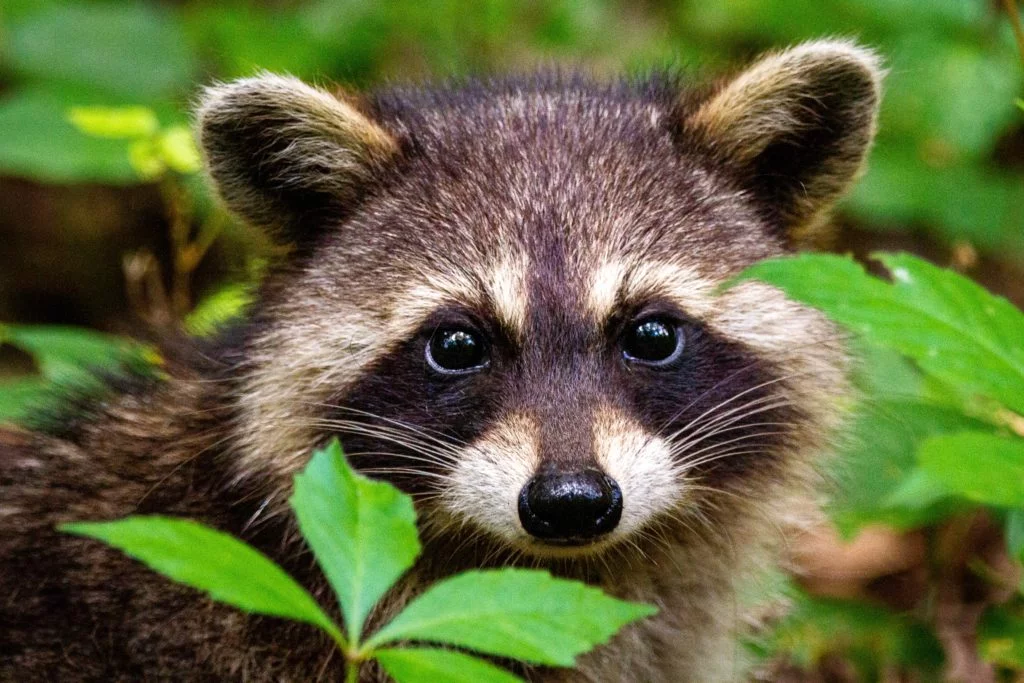How High Can a Raccoon Jump
You may be wondering how high can a raccoon jump when you see one up to your chimney, your rooftop, your attic, on your fence, or a tree; well, raccoons are not that good at jumping. Still, they are pretty good at climbing due to the physical adaptation of their limbs, which is similar to that of a monkey.
Raccoons are very agile animals and can scale almost anything in search of food; they can scale trees, concrete walls, and fences as well. Their unique look and persistence gave them the name “Nature’s bandits” because you can find them in your house scavenging for food at any time of the day or digging up your trash. However, raccoons are generally more active at night. Their dark eye patches also look similar to a bandits mask.
They help the raccoon see better and more clearly; the dark colour help to absorb light as it comes towards the eyes of the raccoon and reduce the light intensity that could have caused obstruction and reduce the vision. It is also an essential trait for seeing at night.
How High Can a Raccoon Jump?
Raccoons can jump just a few feet high due to the nature of their body and the length of their limbs; they are better at jumping off a tree or a building than vertically jumping up. They are good climbers, which is why you can spot one at the topmost part of a tree where it can leap from to land on a rooftop.
Their stubby limbs are pretty much adapted to landing than jumping. The name raccoon was adapted from Powhatan word, which means “animal that scratches its hands,” and they are quite bold and tend to visit and revisit your house if they discover a good source of food, and they might even decide to move in somewhere close by and take residence.
There are about six different raccoons in North and South American, and they all share similar characteristics, which are quite difficult to differentiate them. The raccoon’s physical adaptations that make it a good climber are tare opposable limbs, which gives it a good grip. It enables it to scale buildings and fences in search of food.

Raccoons also constitute house pests as they often destroy household properties. They can easily get into places that would seem pretty difficult for other animals because they have long and elegant claws, enabling them to hold on to narrow cracks on buildings.
Raccoons are also quite an intelligent species of animal, and they can do things like opening lids, turning doorknobs, and so many other things that other rodents can not easily do.
Even though raccoons can only jump up to 4 feet high, it doesn’t stop them from jumping from places as high as 40 meters and landing safely without being injured, and this can be attributed to the fact that raccoons are furry animals, and they have stubby limbs. The forelimbs of the raccoon are shorter than the hinds limbs, which makes it have an arched appearance when running.
Raccoons are also known for being sluggish animals, and they often gain weight ahead of summer, which makes them unable to jump high.
Though squirrels also have similar short forelimbs like raccoons, the body of a raccoon isn’t structured for running fast or jumping high. Raccoons don’t have many natural predators, so they don’t have reason to run very fast or jump high. It also the same thing when it comes to hunting prey.
Raccoon hardly chases or runs after their prey; instead, they hunt for their in its nest where they won’t easily abandon; that is where you often hear of raccoons attacking chicken coop and rabbits.
They are smarter than many domestic and wilds animals like dogs, pigs, chickens, and cats; they can make over 50 different sounds that carry lots of information about a predator, information like the predator’s colour, the speed of the predator, and the level of the of threat.
Raccoons can adapt to any environment, be it dense forest or crowded cities, they can live anywhere, and they can survive on a wide range of diets, eat anything, and have a habit of wetting their food to determine what the food with their sensitive paws.
Just like dogs that have a high sense of smell, raccoons recognize their food or anything with their paws, and their paws become more sensitive in water. They also wash their food to soften and moisten it to make it easier for them to eat and digest.
Even though raccoons can climb at incredible speed, they can’t jump very high from the ground. They are better at jumping off from heights, and they do it fearlessly. They do not have any hidden wings, and they don’t use any form of equipment to do this; their only concern is how hard the ground is.
Furthermore, they have been seen jumping down to land on grass, sand, but they don’t jump off to land on the concrete floor unless in rare cases. Although raccoons are good climbers, they are not good jumpers. Raccoons prefer to climb than jump to get to where they want, even if they could jump to get there faster.
A raccoon normally wouldn’t jump off a building or a tree even when it wouldn’t sustain any injury from doing so; it will rather climb down unless it is in danger of running from a predator or humans. They also jump off when they are in a hurry, like hunting prey or having no way of coming down. So we can conclude that raccoons only jump when it seems to be their last resort.

The raccoon fur helps to protect it from injury when it jumps off a high building; that doesn’t mean it can’t sustain any injury; they can easily be wounded if they jump and land on a concrete floor. It might even break a leg if it jumps carelessly.
Raccoon generally has more weight than cats, and they weigh about 6-9 kg. More weight implies that it’s going to land with more force that can lead to injury when it jumps off. That is why raccoons don’t always jump unless it is completely necessary to do so.
Raccoons are not only good at jumping off, but they are also good at landing on their feet. They do a backflip or frontflip in mid-air to turn themselves to be on the front side and land on their feet, just like cats.
To land on their feet, raccoons use a simple trick, which is; first they twist themselves, then they extend the front legs to maximum, and as it approaches the ground, they land with this front paws first, followed by the back legs. Landing in this manner helps to reduce the chances of getting injured from a fall.
Some may wonder how raccoons get into people’s houses. Well, the simple answer is, they climb or dig their way in instead of jumping. With their opposable limbs and nimble claws, which them a firm grip, they can climb anything, which implies that they climb even when they can easily jump.
Typically, raccoons come down from height head down first instead of jumping, especially from high buildings; this may be because concrete or tiled floor may injure them.
Though raccoons may look adorable, they are annoying/problem types of animals. They may eat the food kept for the pet, and if care is not taken, they may even injure or kill the pet.
The most common complaint about raccoons scaling fences is poultry houses and chicken coops, so they generally find their way into anywhere they perceive food.
Whether you live in the forest or near a park with flowing streams, you are likely going to have a visit from raccoons. They may even try to move in with you once they see a steady food source; they are persistent.
Raccoons are also known as trash pandas and depending on who you ask. They are seen as cute and cuddly animals that transverse from one place to another and another person; they may be a nuisance that urgently needs to be controlled because of the nature of the havoc they are causing.
Whatever the case, knowing more about raccoons will give us a better understanding of what they do, how they live and how high can a raccoon jump. Their body wasn’t made for jumping, so they mark use of the environment. So if you see a raccoon in your house, know that they probably scale the dance or walks to get in.
Their body frame limits them from jumping very high, but their claws and jumping range allow them to scale most fences and houses without difficulty. Given that the origin of their name implies “animals which scratches with hands,” it makes perfect sense and how their paws are adapted to climbing.
Generally, speaking many species and their population has suffered from the growth of the human population over the years. Still, the case is quite the opposite for raccoons; the population has seen a major rise through the past few decades despite the destruction of raccoon habitat by humans because the raccoon has high adaptability. They can survive anywhere, be it urban, rural, or suburban areas.
In residential areas, they are known for living in garbage cans and off pet food that is not properly stored. They can also survive by eating insects, birds, fruits, nuts, and seeds.
The major reason why the raccoon population has been on the rise despite human activities on earth is that they are simply one of the most versatile animals around. Raccoons always find a way to survive in any environment they find themselves in.
Most people in the scientific community see raccoons as very intelligent animals, but how to learn to differ based on their environment. The raccoon in the woodland is pretty smart, but the raccoon found in the urban seems smarter, maybe because of the human factor. The human obstacles raccoons face in cities can not be found this the woodland areas.

Studies that raccoons learned to avoid major road junctions and the same study have also that urban can be more adaptive at open trash can lids where they obtain food items.
In other words, raccoons are intelligent and versatile, and they are very adaptive and can make the most of any environment they find themselves in.
The raccoon has some amazing abilities and features as well, and they are opportunistic omnivores because they travel many miles in a while searching for food. They are always foraging for food and make do with what they have at any point in time.
As a result, they gain weight which makes jumping even more difficult, and as a raccoon advances in age, it becomes less and less interested in any form of jumping. However, raccoons don’t experience any challenges as a result of their inability to jump upwards.
Their brains are very active, making them smart animals, and they can find a way to get food no matter where it may be. Raccoons are so clever that they can unlock latches, pick locks, open doors and even figure out how to stack things for climbing. All these to mention, but a few are why their inability to jump high vertically doesn’t affect them.
However, they can leap horizontally, for instance, from one tree to another. The raccoon has elongated hind legs, which give them the ability to balance upright, enabling them to reach up to remove a trash can lid with their feet still on the ground.
However, their ability to reach is limited by the length of their body. They are less suited or in jumping upward as their body features don’t make it easy. In summary, they can jump but not that high.
Find out:
Hope this article helped you determine How High Can a Raccoon Jump. You may also want to bookmark our article on What Sorts of Food Does Backyard Lizard Eat?
I will love to hear from you if you have any other suggestions on How High Can a Raccoon Jump. All you have to do is comment below. Kindly reach out to people by sharing this post on social media.
If you liked this article, then please follow us on Facebook, Instagram, and Pinterest.
Cheers!
www.backyardcaring.com
How High Can a Raccoon Jump – How far can Raccoons Jump?

